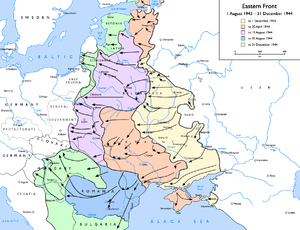Iasi–Kishinev Offensive
| Jassy–Kishinev Offensive | |||||||||
|---|---|---|---|---|---|---|---|---|---|
| Part of the Eastern Front of World War II | |||||||||
 Soviet advance, 1943–1944 |
|||||||||
|
|||||||||
| Belligerents | |||||||||
|
Air support only: |
|
||||||||
| Commanders and leaders | |||||||||
| Units involved | |||||||||
| see below | see below | ||||||||
| Strength | |||||||||
|
Soviet Union: 465,659 men |
Germany: Army Group South Ukraine Romania: 1,224,691 men (40 divisions), 170 tanks, 800 aircraft |
||||||||
| Casualties and losses | |||||||||
|
Soviet Union: 8,586 killed and wounded |
Germany: 150,000 killed, wounded or captured Romania: 8,305 killed 24,989 wounded 170,000 captured or missing 25 aircraft |
||||||||
Allied victory
Soviet Union:
1,314,200 men
16 000 guns
1,870 tanks
2,200 aircraft
Soviet Union:
13,197 killed or missing
53,933 wounded and sick
75 tanks of which 60 destroyed by the 1st Romanian Armored Division on the first day of the offensive
111 aircraft
The Jassy–Kishinev Operation, named after the two major cities, Iași and Chișinău, in the staging area, was a Soviet offensive against Axis forces, which took place in Eastern Romania from 20 to 29 August 1944 during World War II. The 2nd and 3rd Ukrainian Fronts of the Red Army engaged Army Group South Ukraine, which consisted of combined German and Romanian formations, in an operation to reclaim the Moldavian SSR and destroy the Axis forces in the region, opening the way into Romania and the Balkans.
The offensive resulted in the encirclement and destruction of the German forces, allowing the Soviet Army to resume its strategic advance further into Eastern Europe. It also forced Romania to switch allegiance from the Axis powers to the Allies.
The Red Army had made an unsuccessful attack in the same sector, sometimes referred to as First Jassy–Kishinev Offensive, from 8 April to 6 June 1944. In 1944, the Wehrmacht had been pressed back along its entire front line in the East. By May 1944, the South Ukraine Army Group (Heeresgruppe Südukraine) was pushed back towards the prewar Romanian frontier, and managed to establish a line on the lower Dniester River, which was however breached in two places, with the Red Army holding bridgeheads. After June, calm returned to the sector, allowing the rebuilding of the German formations.
...
Wikipedia
